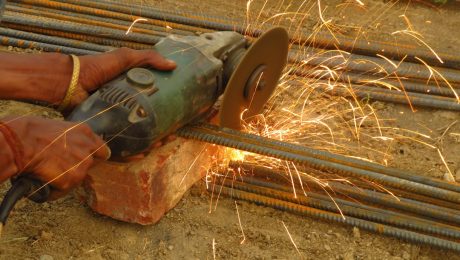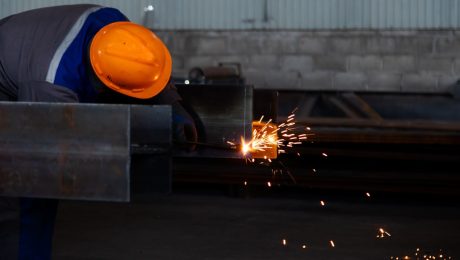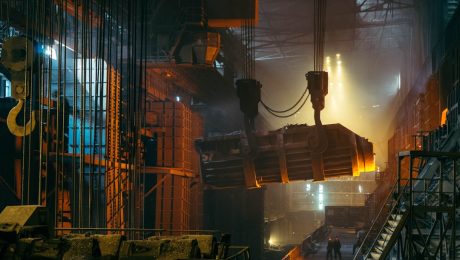Choosing the right piping system is crucial for any construction or plumbing project. Durability, longevity, and cost-effectiveness are all key considerations. Galvanized steel pipes have stood the test of time, proving themselves a reliable and often cost-effective solution. This comprehensive guide delves into the many advantages of galvanized pipes, helping you understand why they remain a popular choice for various applications.
Unmatched Corrosion Resistance: The Heart of Galvanized Steel’s Durability
The primary advantage of galvanized pipes lies in their exceptional corrosion resistance. The galvanization process involves coating the steel pipe with a layer of zinc. This zinc coating acts as a sacrificial anode, meaning it reacts with oxygen and moisture in the environment before the underlying steel can. This prevents rust and significantly extends the lifespan of the pipe. In environments prone to moisture, such as bathrooms, basements, and outdoor applications, this resistance is invaluable. Traditional steel pipes, without galvanization, are highly susceptible to rust and degradation, leading to leaks, costly repairs, and potential structural damage. Galvanized pipes offer a significant upgrade in terms of longevity and maintenance reduction, making them a worthwhile investment.
Exceptional Strength and Durability: Built to Last
Beyond corrosion resistance, galvanized steel pipes boast exceptional strength and durability. Steel itself is a robust material, capable of withstanding high water pressure and significant impacts. The galvanization process doesn’t compromise this inherent strength; instead, it enhances it by protecting the steel from environmental degradation. This translates to pipes that can withstand the rigors of daily use for many decades. Unlike some alternative materials, galvanized pipes are less prone to cracking, bursting, or sagging under pressure, ensuring a reliable and long-lasting plumbing system.
Cost-Effectiveness: A Balancing Act of Initial Investment and Long-Term Savings
While the initial cost of galvanized pipes might be slightly higher than some other piping materials like PVC, the long-term cost savings are substantial. The extended lifespan and reduced maintenance requirements significantly offset the initial investment. The infrequent need for repairs or replacements translates to lower overall costs over the lifetime of the plumbing system. This makes galvanized pipes an economically sound choice, especially for projects where longevity and reliability are paramount.
Versatility in Applications: From Residential to Industrial Settings
Galvanized pipes are remarkably versatile, suitable for a wide range of applications. They are commonly used in residential plumbing systems for water supply and drainage. However, their strength and durability also make them ideal for industrial settings, where they can handle higher pressures and demanding conditions. From large-scale infrastructure projects to smaller commercial applications, galvanized pipes consistently deliver reliable performance. Their adaptability makes them a go-to choice for various plumbing needs.
Easy Installation and Maintenance: Simplifying the Process
Galvanized pipes are relatively easy to install compared to some alternative materials. Standard threading techniques can be used for connections, making the installation process straightforward for experienced plumbers. While specialized tools might be required for certain applications, the overall installation process is generally less complex and time-consuming than some other piping systems. Furthermore, maintenance is minimal due to the pipes’ inherent durability and corrosion resistance. Regular inspections are sufficient to ensure the system’s continued functionality, reducing the need for frequent repairs or replacements.
In conclusion, galvanized pipes offer a compelling combination of durability, corrosion resistance, cost-effectiveness, versatility, and ease of installation. While other materials might have specific advantages in niche applications, galvanized steel pipes remain a strong contender for a wide range of plumbing and construction projects, offering a reliable and long-lasting solution.
SEO Keywords:
- Galvanized pipes
- Plumbing pipes
- Corrosion resistant pipes
- Durable plumbing
- Steel pipes
Shot blasting is a powerful surface treatment technique used across numerous industries to clean, prepare, and even strengthen various materials. This comprehensive guide will delve into the intricacies of this process, exploring its applications, benefits, and necessary safety precautions. Understanding shot blasting is crucial for anyone involved in manufacturing, construction, or maintenance where surface preparation plays a vital role.
Understanding the Shot Blasting Process: A Step-by-Step Guide
At its core, shot blasting involves propelling abrasive media, typically small, hard metal pellets (the “shot”), at high velocity against a surface. This high-impact process removes contaminants, rust, scale, paint, and other surface imperfections. The process typically involves the following steps:
- Surface Preparation: The workpiece is positioned within the shot blasting cabinet or enclosure. Any loose debris should be removed beforehand to prevent clogging of the equipment.
- Shot Acceleration: A spinning wheel or turbine accelerates the abrasive media to high velocity. The type of equipment used depends on the size and type of workpiece.
- Impact and Cleaning: The accelerated shot impacts the surface, removing contaminants through a combination of kinetic energy and abrasion. The intensity of the blasting can be controlled to achieve the desired surface finish.
- Shot Recovery and Recirculation: In most systems, the spent shot is collected and recirculated, minimizing waste and ensuring consistent blasting performance. A separator removes dust and debris from the shot.
- Post-Processing: After blasting, the workpiece may undergo further processing, such as painting, coating, or further surface treatments.
Types of Shot Blasting Equipment and Their Applications
The choice of shot blasting equipment depends on factors such as the size and shape of the workpiece, the desired surface finish, and the type of material being processed. Common types of equipment include:
- Wheel Blast Machines: These machines use a rotating wheel to propel the abrasive media. They are suitable for a wide range of applications and workpiece sizes.
- Air Blast Machines: These machines use compressed air to propel the abrasive media. They are often used for smaller workpieces or delicate surfaces requiring more precise control.
- Centrifugal Blast Machines: These machines use centrifugal force to propel the media, offering high efficiency and throughput.
- Automated Blast Systems: For high-volume production, automated systems offer increased efficiency and consistency.
Applications span various industries including automotive, aerospace, shipbuilding, construction, and metal fabrication. Common uses include cleaning castings, preparing surfaces for painting, removing rust and corrosion, and improving surface fatigue strength.
Benefits of Utilizing Shot Blasting Techniques
Shot blasting offers numerous advantages over other surface preparation methods. These include:
- Superior Cleaning: Shot blasting effectively removes contaminants, creating a clean surface for optimal adhesion of coatings.
- Improved Surface Profile: The process creates a roughened surface, increasing the surface area and improving the bond strength of subsequent coatings.
- Enhanced Fatigue Strength: The compressive stresses induced by shot blasting can increase the fatigue strength of metal components.
- Cost-Effectiveness: While the initial investment can be substantial, the efficiency and reduced waste often lead to long-term cost savings.
- Automation Potential: Many shot blasting processes can be automated, increasing productivity and consistency.
Safety Precautions During Shot Blasting Operations
Shot blasting involves high-velocity projectiles and can pose significant safety risks if proper precautions are not taken. Essential safety measures include:
- Personal Protective Equipment (PPE): Workers must wear appropriate PPE, including safety glasses, hearing protection, respirators, and protective clothing to prevent injuries from flying debris and abrasive dust.
- Enclosure and Containment: The shot blasting process should be contained within an enclosed cabinet or chamber to prevent the escape of abrasive media and dust.
- Regular Maintenance: Regular maintenance of the equipment is essential to ensure safe and efficient operation. This includes checking for wear and tear, ensuring proper ventilation, and regularly inspecting safety systems.
- Training and Supervision: Workers should receive thorough training on safe operating procedures and emergency response protocols. Experienced supervision is crucial, especially for new operators.
- Emergency Procedures: Clear emergency procedures should be in place and regularly practiced to handle any accidents or equipment malfunctions.
Choosing the Right Abrasive Media for Shot Blasting
The selection of abrasive media is crucial for achieving the desired surface finish and minimizing damage to the workpiece. Different types of media are available, each with its own characteristics and applications:
- Steel Shot: A common choice for its versatility and effectiveness in removing heavy contaminants.
- Steel Grit: Offers a more aggressive cleaning action than steel shot, suitable for removing heavy scale and rust.
- Cast Iron Shot: A softer media, often used for cleaning delicate surfaces or preventing damage to softer materials.
- Glass Beads: A very fine media used for finishing and polishing applications, creating a smooth surface.
- Ceramic Media: Various ceramic media are available, offering different levels of hardness and aggressiveness.
The choice of media depends on the material being blasted, the desired surface finish, and the level of contamination to be removed. Careful consideration of these factors is essential for optimal results.
Shot blasting is a versatile and powerful surface treatment technique offering significant advantages across various industries. By understanding the process, its applications, and safety precautions, businesses can leverage its benefits to improve product quality, efficiency, and safety.
body {
font-family: sans-serif;
line-height: 1.6;
margin: 20px;
}
h1, h2, h3 {
color: #333;
}
h1 {
font-size: 2.5em;
}
h2 {
font-size: 2em;
}
h3 {
font-size: 1.5em;
}
Annealed wire, known for its ductility and ease of shaping, plays a crucial role in numerous industries. This process of controlled heating and cooling significantly alters the metal’s properties, making it incredibly versatile. This comprehensive guide delves into the multifaceted applications of annealed wire, showcasing its importance in modern manufacturing and beyond.
Annealed Wire in Electrical Applications
The electrical industry is a major consumer of annealed wire. Its high conductivity and flexibility make it ideal for various applications, including:
- Wiring in appliances and electronics: Annealed copper wire is extensively used in household appliances, electronic devices, and computer components due to its excellent electrical conductivity and ability to be easily formed into intricate shapes.
- Power transmission lines: While often requiring additional strengthening, annealed copper and aluminum wires form the basis of many power transmission lines, facilitating the efficient distribution of electricity over long distances.
- Wiring harnesses: The flexibility of annealed wire allows for the creation of complex wiring harnesses in automobiles and other vehicles, connecting various electrical components.
- Coils and transformers: The ability to be easily wound makes annealed wire perfect for the construction of coils and transformers, essential components in electrical systems.
Annealed Wire in the Construction Industry
Annealed wire finds its place in the construction industry, primarily for its strength and weldability:
- Reinforcement in concrete: Annealed steel wire is used as reinforcement in concrete structures, significantly increasing their tensile strength and preventing cracking.
- Welding wire: The ease of melting and shaping makes annealed wire an excellent choice for welding applications, enabling strong and reliable joints.
- Mesh and fencing: Annealed wire is used to create wire mesh for various applications, including fencing, reinforcing plaster, and creating support structures.
- Pre-stressed concrete: High-strength annealed steel wires are employed in pre-stressed concrete structures, enhancing their load-bearing capacity.
Annealed Wire in Manufacturing and Industrial Processes
Beyond electrical and construction uses, annealed wire is essential in diverse manufacturing processes:
- Spring manufacturing: The elasticity and ductility of annealed wire make it perfect for producing springs of various shapes and sizes, used in countless mechanical applications.
- Wire forming and bending: The ability to easily bend and shape annealed wire facilitates the production of various components, from paper clips to complex automotive parts.
- Braiding and weaving: Annealed wire is used in the creation of braided and woven structures, often employed in industrial applications requiring flexibility and strength.
- Metal mesh fabrication: Various types of metal mesh, used in filtration, sieving, and other industrial processes, are often manufactured using annealed wire.
The Role of Annealed Wire in the Jewelry and Crafts Industry
The malleability of annealed wire makes it a favorite in crafting and jewelry-making:
- Jewelry making: Annealed precious metals like gold and silver are easily shaped and manipulated to create intricate jewelry designs.
- Wire wrapping: Annealed wire is ideal for wire wrapping techniques, allowing for the creation of decorative pieces and embellishments.
- Beading and wirework: Its flexibility allows for the easy creation of beaded jewelry and other wirework projects.
- Sculpting and artistic applications: Artists utilize annealed wire in sculpting and creating three-dimensional artwork.
Understanding the Types and Properties of Annealed Wire
Annealed wire comes in various materials, each with unique properties:
- Annealed Copper Wire: High conductivity and ductility, ideal for electrical applications.
- Annealed Steel Wire: High tensile strength, used in construction and manufacturing.
- Annealed Aluminum Wire: Lightweight and conductive, used in power lines and various applications.
- Annealed Precious Metal Wire (Gold, Silver, Platinum): Malleable and easily worked, popular in jewelry making.
- Annealed Stainless Steel Wire: Corrosion resistant and strong, used in various industrial applications.
The specific properties of annealed wire depend on the base metal, the annealing process, and the desired final characteristics. Understanding these properties is critical for selecting the appropriate wire for any given application.
In conclusion, the versatility of annealed wire makes it an indispensable material across a wide range of industries. From powering our homes to crafting intricate jewelry, its unique properties continue to drive innovation and efficiency in countless applications.
SEO Tags:
annealed wire, wire applications, annealed wire uses, industrial wire, electrical wire
Winter’s harsh conditions can wreak havoc on outdoor structures and equipment. From freezing temperatures and heavy snowfall to de-icing salts, the elements pose a significant challenge to the longevity and performance of various materials. However, galvanized steel, with its protective zinc coating, stands as a reliable choice for withstanding these extreme conditions. This comprehensive guide delves into the performance of galvanized products in cold climates, addressing key concerns and providing valuable insights for homeowners, contractors, and engineers alike.
Corrosion Resistance in Sub-Zero Temperatures
One of the primary advantages of galvanized steel is its exceptional corrosion resistance. The zinc coating acts as a sacrificial anode, protecting the underlying steel from rust and degradation. Even in sub-zero temperatures, where corrosion processes might be expected to slow down, the zinc layer continues to offer robust protection. The key is the quality of the galvanization process. Hot-dip galvanizing, which involves immersing the steel in molten zinc, provides a thicker, more uniform coating than other methods, ensuring superior protection in harsh winter environments. However, it’s important to note that extremely low temperatures can slightly affect the zinc’s reactivity. While it doesn’t compromise the protective layer’s integrity, it can marginally reduce the rate of self-healing in minor scratches compared to warmer temperatures. This difference is usually negligible in the context of long-term performance.
Impact of Snow and Ice Accumulation
Heavy snow and ice accumulation can put considerable stress on structures and equipment. Galvanized steel, due to its inherent strength and durability, can effectively withstand these loads. However, the design and installation of galvanized products are crucial. Properly engineered structures with sufficient load-bearing capacity are essential to prevent damage from excessive snow and ice buildup. Regular snow removal is also recommended to minimize stress and potential damage. Furthermore, the smooth surface of galvanized steel helps prevent ice from adhering as strongly as it might to rougher surfaces, simplifying the cleaning process.
Thermal Expansion and Contraction
Fluctuations in temperature between freezing and thawing can lead to thermal expansion and contraction in materials. Galvanized steel, like other metals, experiences this phenomenon. While this expansion and contraction is typically minimal, it’s important to consider it during design and installation. Proper expansion joints and fasteners can accommodate these movements, preventing stress buildup and potential damage. Failure to account for thermal expansion can lead to cracking or warping of galvanized products over time, especially in situations with significant temperature swings.
Maintenance of Galvanized Products in Cold Climates
While galvanized steel is inherently durable, regular maintenance can extend its lifespan significantly, particularly in challenging winter conditions. Routine inspections can help identify any minor damage or corrosion early on, allowing for timely repairs. Removing snow and ice promptly prevents excessive weight buildup and potential damage. Cleaning away de-icing salts, which can be corrosive over time, is also crucial. A simple rinse with water after a snowfall or ice storm can significantly reduce the risk of salt-induced corrosion. For more significant damage, repainting or touch-up with a zinc-rich primer can restore the protective layer.
Choosing the Right Galvanized Steel for Extreme Cold
Not all galvanized steel is created equal. The thickness of the zinc coating, the type of steel used (e.g., different grades with varying yield strengths), and the overall quality of the galvanizing process all play a role in its performance in extreme cold. For applications in extremely harsh winter environments, it is essential to specify high-quality, hot-dip galvanized steel with a thicker zinc coating. Consulting with a materials specialist can help you select the appropriate grade of galvanized steel that meets the specific requirements of your project and the expected environmental conditions. Consider factors like the anticipated snow load, wind speed, and average winter temperatures when making your selection.
In conclusion, galvanized steel proves to be a reliable and cost-effective material for various applications in cold climates. Understanding its performance characteristics, implementing proper design and installation practices, and performing routine maintenance can significantly extend the lifespan and functionality of galvanized products, ensuring they withstand the rigors of winter’s harshest conditions.
Tags: galvanized steel, cold climate, corrosion resistance, winter maintenance, thermal expansion, snow load, zinc coating
Cold drawn flat bars are a cornerstone of numerous industries, providing exceptional dimensional accuracy and superior mechanical properties. This comprehensive guide delves into the world of cold drawn flat bars, exploring their manufacturing process, characteristics, applications, and considerations for selection.
The Manufacturing Process of Cold Drawn Flat Bars
The creation of cold drawn flat bars begins with hot-rolled steel bars. These bars, already possessing a basic shape, undergo a series of crucial steps to achieve the desired precision and quality. The process starts with pickling, a chemical cleaning process that removes surface oxides and scale. Next, the bars are cold drawn through a series of dies, progressively reducing their cross-sectional area and improving their surface finish. This cold drawing process significantly increases the tensile strength and yield strength of the steel while simultaneously enhancing its dimensional accuracy. The final step often involves straightening and cutting to the required lengths. The precise control over temperature and reduction during cold drawing allows for extremely tight tolerances, making cold drawn flat bars ideal for applications demanding high precision.
Mechanical Properties and Material Composition of Cold Drawn Flat Bars
Cold drawing significantly alters the mechanical properties of the starting steel. Compared to hot-rolled counterparts, cold drawn flat bars exhibit:
- Higher Tensile Strength: The cold working process strengthens the metal’s crystalline structure, leading to increased tensile strength.
- Improved Yield Strength: The yield point, the stress at which permanent deformation begins, is also significantly elevated.
- Enhanced Surface Finish: The drawing process results in a smoother, more refined surface, reducing the need for further finishing operations.
- Better Dimensional Accuracy: Cold drawing allows for the production of bars with exceptionally tight tolerances.
- Increased Hardness: The cold working process increases the hardness of the steel, making it more resistant to wear and tear.
Common materials used for cold drawn flat bars include low carbon steel, medium carbon steel, high carbon steel, alloy steels, and stainless steels. The specific material selection depends heavily on the intended application and the required mechanical properties.
Diverse Applications of Cold Drawn Flat Bars Across Industries
The versatility and precision of cold drawn flat bars make them indispensable in a wide range of industries. Some key applications include:
- Automotive: Used in chassis components, suspension parts, and other structural elements requiring high strength and dimensional accuracy.
- Construction: Employed in structural components, reinforcing bars, and other applications where strength and durability are paramount.
- Machinery Manufacturing: A critical component in various machine parts, requiring precise dimensions and excellent mechanical properties.
- Aerospace: Used in aircraft components where lightweight yet high-strength materials are essential.
- Medical Devices: In applications requiring biocompatibility and precision, specific grades of stainless steel cold drawn flat bars are utilized.
- Agricultural Equipment: Used in components that need to withstand harsh conditions and heavy loads.
The specific grade of steel chosen will depend on the demands of the application, considering factors such as corrosion resistance, fatigue strength, and required hardness.
Advantages and Disadvantages of Utilizing Cold Drawn Flat Bars
While offering many benefits, it’s crucial to understand both the advantages and disadvantages of using cold drawn flat bars:
Advantages:
- Superior Dimensional Accuracy: Exceptional tolerances make them ideal for precision engineering applications.
- Enhanced Mechanical Properties: Higher tensile and yield strength compared to hot-rolled counterparts.
- Excellent Surface Finish: Reduces the need for secondary finishing processes, saving time and cost.
- Wide Material Selection: Available in various steel grades to meet diverse application requirements.
- Cost-Effective for Precision Parts: The improved accuracy often reduces machining time and waste.
Disadvantages:
- Higher Initial Cost: The manufacturing process is more complex than hot rolling, resulting in a higher initial cost.
- Limited Size Range: Compared to hot-rolled bars, the available sizes might be more restricted.
- Potential for Residual Stresses: Cold working can induce residual stresses, which might need to be considered in design.
- Work Hardening: Excessive cold working can lead to work hardening, making the material more brittle.
Careful consideration of these factors is crucial for optimal material selection and design.
Selecting the Right Cold Drawn Flat Bar for Your Needs
Choosing the appropriate cold drawn flat bar involves considering several key factors:
- Material Grade: Select the grade based on the required strength, hardness, corrosion resistance, and other mechanical properties.
- Dimensions and Tolerances: Specify the exact dimensions and acceptable tolerances to ensure a precise fit.
- Surface Finish: Define the required surface roughness for the application.
- Quantity and Delivery Time: Consider the project’s scale and required delivery timeframe.
- Cost: Balance the initial cost with the long-term benefits of using a high-quality material.
Consulting with a materials specialist can help ensure the correct selection for your specific application.
In conclusion, cold drawn flat bars offer a compelling combination of precision, strength, and versatility, making them an essential material in a wide range of industries. Understanding their properties and selection criteria is crucial for engineers and manufacturers seeking high-quality, reliable components.
The steel industry is a cornerstone of modern infrastructure, offering rewarding careers for skilled professionals. If you’re drawn to the challenge of working with steel, building skyscrapers, bridges, and other vital structures, then a steelworker training program is the perfect path for you. This guide explores the various avenues available to enter this exciting and demanding field.
1. Types of Steelworker Training Programs: Finding the Right Fit
The path to becoming a steelworker varies depending on your background, learning style, and career goals. Several options exist, each with its own advantages and disadvantages:
- Apprenticeships: These are hands-on, on-the-job training programs typically lasting 3-5 years. Apprentices work alongside experienced steelworkers, learning practical skills while earning a wage. They combine classroom instruction with on-site experience, leading to a nationally recognized certification upon completion. This is often considered the gold standard for steelworker training.
- Trade Schools and Vocational Schools: These institutions offer shorter, more focused programs, usually lasting several months to a year. They provide a solid foundation in welding, rigging, blueprint reading, and other essential skills. While lacking the extensive on-the-job experience of apprenticeships, they offer a faster entry point into the field.
- Community Colleges and Technical Institutes: These institutions offer associate degrees or certificates in related fields like welding technology or construction management. These programs often provide a broader education, including theoretical knowledge and safety training, which can be beneficial for career advancement.
- Union Training Programs: Many unions offer extensive training programs for their members, providing specialized skills and opportunities for advancement within the union’s network of contractors.
2. Essential Skills Covered in Steelworker Training
Regardless of the chosen training path, several core skills are crucial for success as a steelworker. These include:
- Welding: Proficiency in various welding techniques (SMAW, GMAW, FCAW, etc.) is essential for joining steel components.
- Blueprint Reading and Interpretation: Understanding construction drawings is vital for accurately assembling steel structures.
- Rigging and Hoisting: Safe and efficient handling of heavy steel components using cranes, hoists, and other equipment is critical.
- Safety Procedures and Regulations: The steel industry is inherently hazardous, requiring strict adherence to safety protocols and regulations to prevent accidents.
- Use of Hand and Power Tools: Steelworkers use a wide range of tools, from basic hand tools to specialized power tools, requiring proficiency in their safe and effective operation.
- Mathematical Skills: Basic geometry, trigonometry, and measurement skills are essential for precise work.
- Physical Fitness and Stamina: The job demands significant physical strength, endurance, and dexterity.
3. Certification and Licensing Requirements for Steelworkers
Certification and licensing requirements vary depending on location and specific job roles. However, many employers prefer or require certification demonstrating competency in welding and other specialized skills. Common certifications include:
- American Welding Society (AWS) certifications:</ These certifications validate welding skills and proficiency in different welding processes.
- National Center for Construction Education and Research (NCCER) certifications:</ NCCER provides industry-recognized certifications in various construction trades, including steel erection.
- OSHA 10-hour or 30-hour certifications:</ These certifications demonstrate knowledge of workplace safety regulations, crucial for working in the construction industry.
It’s essential to research the specific requirements for your target location and employer.
4. Career Progression and Advancement Opportunities in the Steel Industry
The steel industry offers excellent career progression opportunities for skilled and dedicated workers. Starting as a steelworker, individuals can advance to positions such as:
- Foreman/Supervisor: Overseeing crews and ensuring projects are completed safely and efficiently.
- Ironworker: Specializing in the installation of structural steel and reinforcing bars.
- Welding Inspector: Inspecting welds for quality and compliance with standards.
- Construction Project Manager: Managing large-scale construction projects involving steel structures.
Continuous learning and professional development are essential for career advancement. Seeking advanced certifications, attending workshops, and gaining experience in different areas of the industry can significantly enhance career prospects.
5. Finding and Choosing the Right Steelworker Training Program
Choosing the right training program is crucial for a successful career. Consider the following factors:
- Accreditation and Reputation: Choose programs accredited by recognized organizations like NCCER or AWS.
- Curriculum and Instruction Methods: Ensure the program covers the essential skills and uses effective teaching methods.
- Job Placement Assistance: Many programs offer assistance with finding employment after graduation.
- Cost and Financial Aid: Explore funding options, such as scholarships, grants, and loans, to cover tuition and other expenses.
- Location and Accessibility: Choose a program that’s conveniently located and accessible to you.
- Instructor Experience and Expertise: Look for programs with experienced and knowledgeable instructors.
Thoroughly research different programs and compare them based on these factors to make an informed decision.
By investing in a quality steelworker training program, you’re investing in a rewarding and stable career with excellent earning potential and opportunities for growth. The demand for skilled steelworkers remains high, making it a smart choice for individuals seeking a challenging and fulfilling career path.
Tags: steelworker training, steelworker certification, welding training, ironworker training, construction training
Turkey’s steel industry has experienced remarkable growth in recent decades, transforming from a relatively small player to a significant force in the global steel market. This ascent is a testament to strategic investments, technological advancements, and a focused approach to international trade. This article delves into the key factors contributing to Turkey’s steel success, examining its strengths, challenges, and future prospects.
The Rise of Turkish Steel Production
Turkey’s steel production has witnessed exponential growth, fueled by robust domestic demand and strategic investments in modern steel mills. The country boasts a diversified production base, encompassing integrated steel plants and electric arc furnaces (EAFs). Integrated steel plants, using iron ore as a primary raw material, produce a wide range of steel grades, while EAFs, utilizing scrap metal, are increasingly important for producing high-quality steel efficiently and sustainably. This dual approach allows Turkey to cater to a broad spectrum of customer needs, from construction and automotive to shipbuilding and machinery manufacturing. Government support through infrastructure development and favorable trade policies has further stimulated growth, creating a supportive environment for both domestic and foreign investment in the sector.
Key Players and Their Global Reach
Several major players drive Turkey’s steel industry’s global presence. Companies like Erdemir, Kardemir, and Tosyalı Holding are prominent examples, each with significant export capabilities and a global network of clients. These companies have invested heavily in advanced technologies and quality control measures, ensuring their products meet international standards. Their success is not solely dependent on price competitiveness; they also focus on delivering high-quality steel tailored to specific customer requirements. This strategy has allowed them to penetrate markets where price alone isn’t the deciding factor, establishing long-term relationships with international buyers and securing a strong foothold in various global sectors.
Export Strategies and Market Penetration
Turkey’s steel export strategy is multifaceted. The focus is on diversifying export markets, reducing reliance on any single country or region. This strategic approach mitigates risks associated with economic fluctuations or geopolitical instability in specific markets. Aggressive pricing strategies, coupled with the provision of customized steel solutions, have allowed Turkish steel producers to compete effectively in both developed and developing economies. Active participation in international trade fairs and building strong relationships with importers have further enhanced market penetration. Furthermore, the strategic location of Turkey, bridging Europe and Asia, offers significant logistical advantages, facilitating efficient and cost-effective delivery to various global destinations.
Challenges and Opportunities for Future Growth
Despite its remarkable progress, the Turkish steel industry faces several challenges. Fluctuations in global steel prices, competition from other major steel-producing nations, and environmental concerns related to steel production are significant hurdles. The industry needs to adapt to evolving global demand, focusing on value-added products and sustainable production practices. Investing in research and development to produce innovative steel products with enhanced properties is crucial for maintaining a competitive edge. Addressing environmental concerns through the adoption of cleaner technologies and reducing carbon emissions is essential for long-term sustainability and securing market access in increasingly environmentally conscious markets.
The Future of Turkish Steel in the Global Landscape
The future of Turkish steel in the global market looks promising, provided the industry proactively addresses the existing challenges. Continued investment in modernizing production facilities, adopting sustainable practices, and focusing on innovation will be vital. Developing niche steel products with specialized properties tailored to specific industry needs will be key to securing market share in increasingly competitive markets. Collaboration between industry players, academia, and the government is essential to foster technological advancements and promote the sustainable growth of the Turkish steel sector. By leveraging its strategic location, skilled workforce, and growing industrial base, Turkey can solidify its position as a major player in the global steel market for years to come.
Tags: Turkish steel, global steel market, steel exports, Turkish steel industry, steel production
Steel, a ubiquitous material in modern construction, manufacturing, and infrastructure, exists in various forms, ranging from its raw, unrefined state to highly processed finished products. Understanding the differences between raw and finished steel is crucial for anyone involved in selecting materials for a project, or simply curious about the steelmaking process. This comprehensive guide delves into the key distinctions between these two forms of steel, exploring their properties, applications, costs, and the transformative processes they undergo.
1. The Raw Reality: Understanding the Properties of Raw Steel
Raw steel, also known as pig iron or molten steel, is the initial product of the steelmaking process. It’s the result of smelting iron ore in a blast furnace, a process that reduces the iron oxides to metallic iron. This raw steel is far from the refined material we typically associate with steel construction. It contains significant impurities, including carbon, manganese, silicon, phosphorus, and sulfur. These impurities significantly affect its properties, rendering it brittle, weak, and unsuitable for most engineering applications. Its high carbon content makes it very hard but also extremely brittle. It’s typically not used directly in construction or manufacturing due to its inferior mechanical properties and lack of durability. The high levels of impurities also make it susceptible to corrosion and oxidation. Its primary use is as an intermediary step in the steelmaking process, destined for further refinement.
2. The Transformation: Refining Raw Steel into Finished Steel
The journey from raw steel to finished steel involves a series of crucial refining processes. The most common method is the Basic Oxygen Furnace (BOF) process, which utilizes oxygen to burn off impurities, reducing the carbon content and improving the steel’s overall quality. Other methods include the electric arc furnace (EAF) process, which is particularly effective for recycling scrap steel. These processes carefully control the chemical composition, resulting in steel with precisely defined properties. After refining, the steel is cast into various forms, such as slabs, blooms, or billets, depending on its intended application. These semi-finished products then undergo further processing, such as hot rolling, cold rolling, or forging, to achieve the desired shape, size, and properties.
3. A Spectrum of Properties: Comparing the Mechanical Characteristics
The mechanical properties of raw and finished steel differ dramatically. Raw steel, due to its high impurity content, exhibits low tensile strength, low ductility (ability to deform before breaking), and low impact resistance. Finished steel, on the other hand, boasts significantly improved mechanical properties. Through careful control of the chemical composition and the refining process, manufacturers can tailor the steel’s properties to meet specific requirements. For instance, high-strength low-alloy (HSLA) steels are designed for superior strength and weldability, while stainless steels offer excellent corrosion resistance. The precise properties of finished steel are determined by its chemical composition, the refining process, and the subsequent shaping and heat treatments it undergoes. This allows for a wide range of applications, from skyscrapers to surgical instruments.
4. Diverse Applications: Exploring the Uses of Raw vs. Finished Steel
The differences in properties directly influence the applications of raw and finished steel. Raw steel, given its inherent flaws, has limited direct applications. It primarily serves as a feedstock for the production of finished steel products. Finished steel, however, enjoys a vast array of applications. Structural steel, used in buildings and bridges, is a prime example. Other applications include automotive parts, appliances, pipelines, railway tracks, and countless other industrial and consumer products. The versatility of finished steel stems from the ability to tailor its properties to suit the specific demands of each application. The choice of steel grade depends on factors such as strength requirements, corrosion resistance, weldability, and cost.
5. Cost Considerations: The Economic Implications of Choosing Raw vs. Finished Steel
The cost of raw and finished steel also differs significantly. Raw steel, being an intermediary product, is generally cheaper than finished steel. However, this lower cost comes at the expense of its inferior quality and limited usability. Finished steel, with its enhanced properties and readiness for immediate use, commands a higher price. The cost of finished steel varies depending on the grade of steel, the manufacturing process, and the market conditions. Factors such as alloying elements, surface treatments, and the complexity of shaping also influence the final cost. For engineers and contractors, the choice between raw and finished steel involves a careful balancing act between cost and performance, considering the long-term implications of material selection on the project’s success.
In conclusion, the differences between raw and finished steel are substantial, extending beyond mere appearance to encompass fundamental properties, applications, and cost. Understanding these differences is critical for informed decision-making in any industry that utilizes steel. From the initial smelting process to the final product, the journey of steel exemplifies the power of materials science and engineering to transform raw materials into versatile and indispensable components of our modern world.
SEO Tags:
- Raw Steel
- Finished Steel
- Steel Properties
- Steel Manufacturing Process
- Steel Applications
The global steel industry is a fiercely competitive landscape, with established players and emerging economies vying for market share. However, one nation has consistently proven its ability to not only compete but thrive: Turkey. Turkish steel has carved a significant niche for itself, offering a compelling blend of quality, cost-effectiveness, and strategic advantages that position it as a major force in the international steel market. This post delves into the key factors contributing to Turkish steel’s competitive edge.
Strategic Location and Infrastructure
Turkey’s geographical location acts as a significant catalyst for its steel industry’s success. Situated at the crossroads of Europe and Asia, it enjoys unparalleled access to both Eastern and Western markets. This strategic position reduces transportation costs and lead times, making Turkish steel a highly attractive option for buyers worldwide. Furthermore, Turkey has invested heavily in developing its infrastructure, including ports, railways, and highways. This robust infrastructure ensures the efficient and timely delivery of steel products to global destinations, further enhancing its competitive advantage.
Abundant Raw Materials and Resources
The availability of abundant and relatively low-cost raw materials plays a pivotal role in the competitiveness of Turkish steel. The country possesses significant iron ore reserves, although it also relies on imports to supplement its domestic supply. Access to these resources, coupled with a well-established mining and processing sector, minimizes reliance on external suppliers and helps keep production costs down. This cost advantage is crucial in a global market where price competition is intense. Efficient resource management and strategic partnerships with international suppliers further strengthen this competitive edge.
Technological Advancements and Modernization
The Turkish steel industry has made significant strides in adopting advanced technologies and modernizing its production processes. This commitment to innovation has resulted in increased efficiency, higher product quality, and reduced environmental impact. Many Turkish steel mills have invested in state-of-the-art equipment, including electric arc furnaces, continuous casting machines, and advanced rolling mills. These technological upgrades allow for the production of a wider range of steel grades with enhanced properties, catering to the diverse needs of various industries. The focus on automation and process optimization has also contributed to improved productivity and lower operational costs.
Skilled Workforce and Competitive Labor Costs
Turkey boasts a large and relatively skilled workforce in the steel industry. Years of experience and ongoing training programs have fostered a pool of skilled engineers, technicians, and laborers capable of operating and maintaining complex steelmaking equipment. Furthermore, competitive labor costs compared to many other steel-producing nations provide a significant cost advantage. This combination of skilled labor and competitive wages makes Turkish steel production more cost-effective, allowing for competitive pricing in the global market without compromising on quality.
Government Support and Export Promotion
The Turkish government has actively supported the growth and development of its steel industry through various initiatives. These include providing financial incentives, streamlining regulations, and promoting exports. Government agencies actively participate in international trade fairs and exhibitions, fostering relationships with potential buyers and showcasing the capabilities of Turkish steel producers. This proactive approach has helped Turkish steel companies expand their global reach and solidify their position in the international market. Furthermore, strategic partnerships and collaborations with foreign investors have also facilitated technological advancements and market expansion.
In conclusion, Turkish steel’s competitive edge is a result of a multifaceted strategy encompassing strategic location, abundant resources, technological advancements, a skilled workforce, and supportive government policies. This synergistic combination allows Turkish steel producers to offer high-quality products at competitive prices, making them a significant and increasingly influential player in the global steel market. The future looks bright for Turkish steel, as it continues to innovate and adapt to the evolving demands of the international landscape.
SEO-Friendly Tags:
- Turkish Steel Industry
- Global Steel Market
- Steel Production in Turkey
- Turkish Steel Exports
- Competitive Steel Prices
body { font-family: sans-serif; line-height: 1.6; }
h1, h2, h3 { color: #333; }
img { max-width: 100%; height: auto; }
Power plants, the behemoths of energy generation, rely on robust and reliable infrastructure. While the turbines and generators often steal the spotlight, a critical yet often overlooked component is the extensive use of steel profiles. These seemingly simple shapes – beams, channels, angles, and more – play a vital role in the structural integrity, operational efficiency, and overall safety of these complex facilities. This post delves into the multifaceted world of steel profiles in power plants, exploring their diverse applications, material selection, and the crucial role they play in ensuring consistent and safe energy production.
1. Structural Support: The Backbone of Power Plant Infrastructure
Steel profiles form the very backbone of power plant structures. From the massive frameworks supporting boilers and turbines to the intricate scaffolding used during construction and maintenance, their strength and versatility are indispensable. Heavy-duty I-beams and H-beams are commonly employed to support the immense weight of equipment, while lighter channels and angles are used for bracing and secondary support structures. The ability of steel to withstand high temperatures and pressures, coupled with its excellent tensile strength, makes it the ideal material for these demanding applications. Proper design and engineering, considering factors like wind load, seismic activity, and thermal expansion, are crucial for ensuring the structural integrity of the entire plant.
2. Material Selection: Balancing Strength, Corrosion Resistance, and Cost
Choosing the right steel profile is a critical decision that impacts both performance and longevity. The selection process considers several factors, including the intended application, the operating environment, and budgetary constraints. Commonly used steel grades include carbon steel, which offers a good balance of strength and cost-effectiveness, and high-strength low-alloy (HSLA) steel, which boasts enhanced strength and weldability. For applications exposed to harsh environments, such as coastal power plants, corrosion-resistant steels, like stainless steel or weathering steel (Corten steel), are often preferred to mitigate the effects of rust and degradation. The specific grade of steel is carefully chosen to optimize performance and minimize maintenance costs over the plant’s lifespan.
3. Manufacturing Processes and Quality Control: Ensuring Precision and Durability
The precision manufacturing of steel profiles is paramount to their successful integration into power plant structures. Modern steel mills employ advanced rolling and shaping techniques to produce profiles with exacting dimensions and tolerances. Processes like hot-rolling and cold-forming allow for the creation of a wide range of shapes and sizes, tailored to specific design requirements. Rigorous quality control measures are implemented throughout the manufacturing process, ensuring that each profile meets the stringent standards demanded by the power generation industry. This includes regular testing for tensile strength, yield strength, and ductility, as well as inspections for surface defects and dimensional accuracy.
4. Applications Beyond Structural Support: Specialized Roles of Steel Profiles
The application of steel profiles extends beyond mere structural support. They play crucial roles in various specialized areas within a power plant:
- Conveyor Systems: Steel channels and angles form the framework of conveyor systems used to transport coal, ash, and other materials within the plant.
- Piping Supports: Steel profiles provide robust support for the extensive network of pipes carrying steam, water, and other fluids throughout the plant.
- Stairways and Platforms: Steel profiles are essential components in the construction of safe and accessible stairways and platforms for maintenance personnel.
- Electrical Enclosures: Steel profiles are used to create protective enclosures for electrical equipment, ensuring worker safety and equipment protection.
5. Safety and Maintenance: Ensuring Long-Term Performance
The safety and longevity of steel profiles are crucial for the overall operational efficiency and safety of the power plant. Regular inspections and maintenance are essential to detect and address any potential issues, such as corrosion, fatigue, or damage. Proper protective coatings, such as paints or galvanization, can significantly extend the lifespan of steel profiles and prevent premature degradation. Implementing a comprehensive maintenance program, including regular inspections and timely repairs, is vital for ensuring the continued structural integrity and safety of the power plant.
In conclusion, steel profiles are far more than just structural elements; they are the silent workhorses underpinning the reliable and efficient operation of power plants worldwide. Their strength, versatility, and cost-effectiveness make them indispensable components in the design and construction of these critical energy infrastructure facilities. Understanding their diverse applications, material properties, and maintenance requirements is paramount for ensuring the safety and longevity of power generation facilities.
SEO Tags: Steel profiles, power plant construction, structural steel, steel fabrication, energy infrastructure










